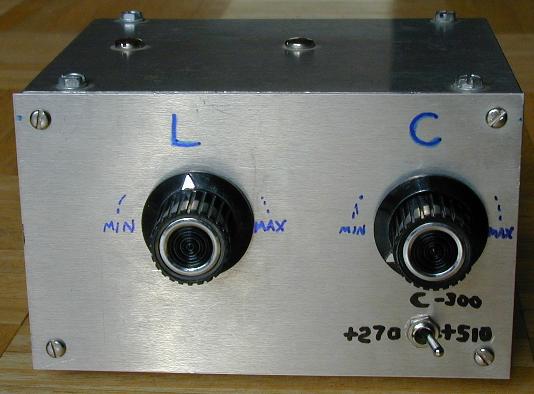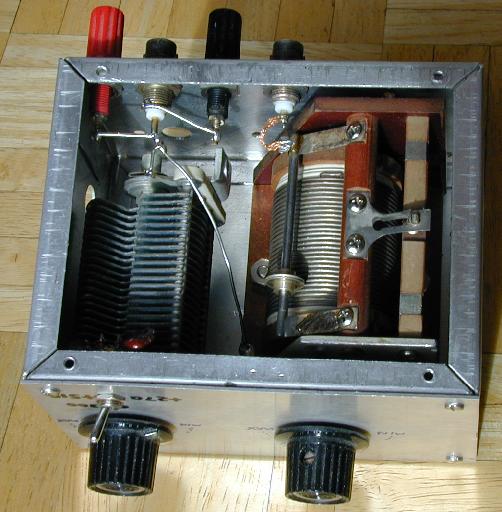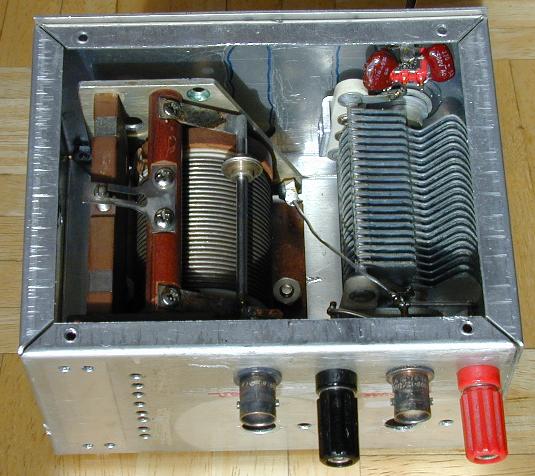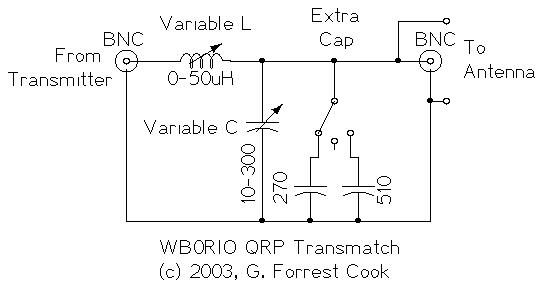QRP Antenna Tuner
(C) G. Forrest Cook 2003




INTRODUCTION
January 30, 2003
This circuit is for a QRP (low power) antenna tuner, a.k.a. a transmatch, for use in the short wave amateur radio bands from 3-30 Mhz. It allows a wide variety of antennas to be connected to a low power transmitter. When the circuit is properly tuned, the maximum transmitter power will be delivered to the antenna. It is used in conjunction with a standing wave ratio (SWR) meter. This is a fairly generic antenna tuner circuit.
Theory
The purpose of a transmatch is to match the impedance of a transmitter, typically 50 ohms, to an unknown antenna impedance. The circuit consists of a variable series inductor followed by a variable capacitor to ground. Most transmitter outputs consist of a PI low pass network. The transmatch is essentially an adjustable extension of that network. With the parts shown, maximum power through the unit is approximately 50 watts.
Construction
Build the tuner in an aluminum project box. Drill holes in the box to mount the various components. Leave plenty of room around the sides of the components to prevent RF arcing. Be sure to keep both sides of the variable inductor insulated from the box, you may need to use insulated bushings (non-conductive washers) on the inductor's shaft. Use heavy hook-up wire to connect the various components together, I recommend 18 gauge tinned cooper wire, or thicker. Use the shortest wire lengths possible. I used the smallest box possible for the components that I had, a larger box would make the project somewhat easier to build.
Use
Connect the transmitter output to the SWR meter, the SWR meter output to the input of the transmatch, and the antenna to the output of the transmatch. Set the capacitance switch to 0 (center), adjust the variable capacitor to the mid point. Adjust the inductor to near the minimum inductance. Briefly transmit and observe the SWR reading.
Increase the inductance until the minimum reflected power and maximum forward power is observed. Adjust the capacitance for the best SWR reading. It is necessary to go back and forth on the adjustments to find the best match. If the best match is found with the capacitor at the max value, switch in either the 270pf or 510 pf parallel capacitors and re-adjust the variable capacitor and inductor.
Be careful not to leave the transmitter on for too long in the unmatched condition, doing so can damage the output transistors. If your transmitter has a variable output power, tune up at low power then re-adjust the circuit at full power. If you are using a vacuum tube transmitter, don't worry about it. Caution: higher power transmitters can generate high voltages in this circuit, don't touch any of the wires when the transmitter is operating. The set screw on the roller inductor knob may be electrically hot during use, you may want to cover it with a drop of plastic glue after tightening
.Parts
- variable inductor (roller), approximately 0-50 uH
- variable capacitor, 0-300pf or 0-360pf, can be scavanged from an old tube radio
- center off spdt switch
- 270pf, 200V silver mica capacitor
- 510pf, 200V silver mica capacitor
- two BNC connectors (or PL-259 if you prefer)
- two banana jacks
- two insulated plastic knobs
- miscellaneous screws, nuts, and washers
- solid hook-up wire, 18 gauge or similar
- aluminum box, big enough to easily contain all of the components
The variable inductor may be difficult to find, the best places to look are at ham radio swap fests and surplus electronics parts companies. A fixed inductor with switched taps can be substituted. An air-core formed inductor will probably give the best results in this circuit, a toroidal ferrite core inductor will also work, but it may absorb some of the available RF power.
Source:www.solorb.com






